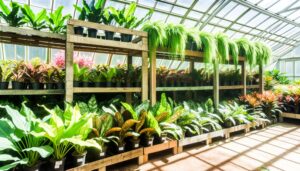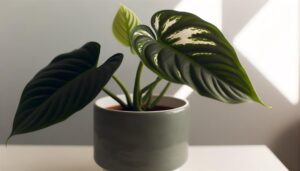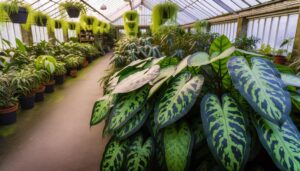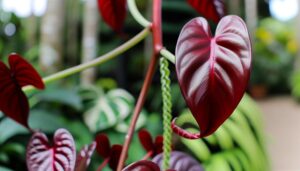What Is a Wild Form of the Philodendron Brandtianum?
The wild form of Philodendron brandtianum inhabits the dense, tropical rainforests of South America. This epiphytic climber thrives in high humidity environments exceeding 70% and relies on dappled sunlight filtered through the forest canopy.
Its heart-shaped leaves, marked by silver variegation on a deep green backdrop, reach up to 12 inches in length. The plant utilizes specialized aerial roots for nutrient uptake and support, while its robust petioles ensure structural integrity.
Adapted to well-draining soil rich in organic matter, Philodendron brandtianum maintains its physiological processes at peak levels at temperatures between 65-80°F. Understanding its ecological interactions reveals more about its intricate adaptations.
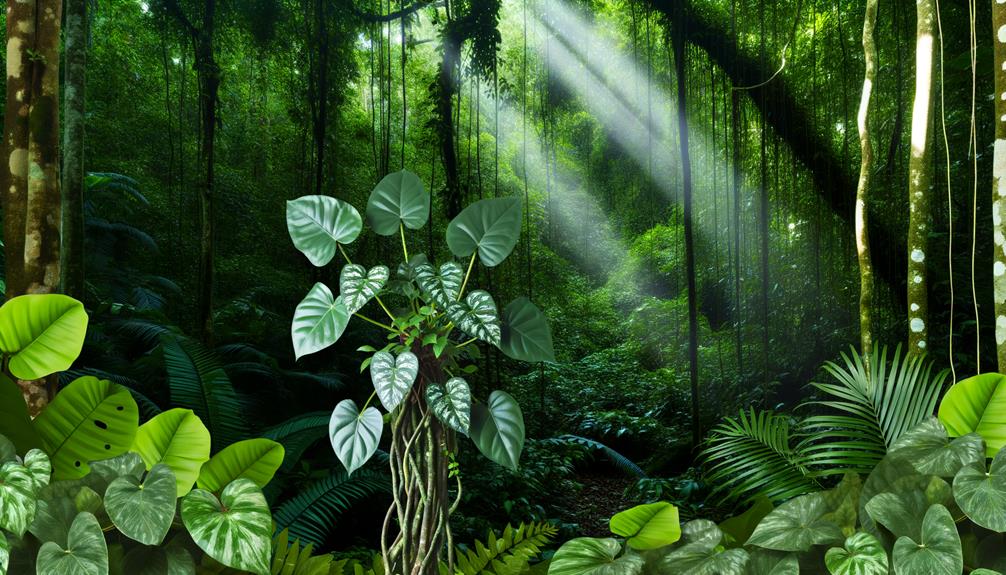
Key Takeaways
- The wild form of Philodendron brandtianum thrives in tropical rainforests.
- It features heart-shaped leaves with silver variegation and deep green color.
- The plant grows epiphytically, using aerial roots to climb and support itself.
- It prefers high humidity levels, often exceeding 70%, for optimal growth.
- Well-draining soil rich in organic matter is essential for its natural habitat.
Native Habitat
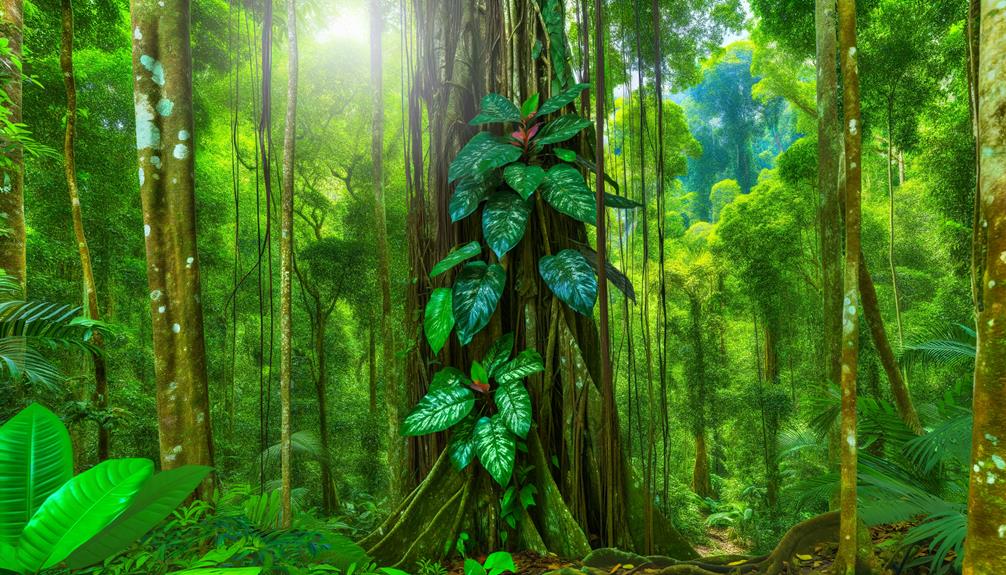
Native to the tropical rainforests of South America, the Philodendron Brandtianum thrives in the understory where it benefits from high humidity, dappled sunlight, and well-draining soil rich in organic matter. This unique ecological niche provides ideal conditions for its growth, leveraging the filtered sunlight that penetrates the dense canopy above.
The high humidity levels, typically exceeding 70%, are essential for maintaining its turgor and promoting lush foliage. Additionally, the well-draining soil prevents waterlogging, which can lead to root rot, while the organic matter supplies essential nutrients. These factors collectively create a microhabitat that supports its epiphytic and terrestrial growth patterns, enabling the Philodendron Brandtianum to flourish amidst the complex biodiversity of its native rainforest environment.
Physical Characteristics
The physical characteristics of the wild Philodendron brandtianum are distinguished by its unique leaf morphology. This includes a variety of shapes and sizes that contribute to its adaptability.
The foliage exhibits a complex coloration and variegation pattern, often with a blend of green, silver, and sometimes bronze hues.
Additionally, its growth habit is mainly climbing, facilitated by aerial roots that anchor to nearby surfaces, showcasing its epiphytic nature.
Leaf Shape and Size
Exhibiting a distinctly elongated, heart-shaped morphology, the leaves of the wild Philodendron Brandtianum can reach up to 12 inches in length and display a striking silver variegation against a deep green backdrop. The leaf blade is typically broad at the base, tapering to a more pointed apex, which enhances its overall aesthetic appeal.
The surface texture of the leaf is generally smooth, with a subtle undulation that contributes to its dynamic appearance. Petioles, the stalks that attach the leaves to the stem, are robust and can extend several inches, offering strong support.
The venation pattern is pinnate, with a prominent central vein and secondary veins that radiate outward, optimizing both structural integrity and nutrient transport within the leaf tissue.
Color and Pattern
Building upon the distinctive leaf morphology, the coloration of the wild Philodendron Brandtianum is characterized by a rich interplay of deep green and striking silver variegation, which manifests in intricate, irregular patterns across the leaf surface.
This variegation serves several functional and aesthetic purposes:
- Photosynthetic Efficiency: The deep green areas are high in chlorophyll, optimizing photosynthesis.
- Camouflage: Irregular patterns provide a natural camouflage in diverse habitats.
- Moisture Regulation: Silver variegation reflects sunlight, reducing water loss.
- Visual Appeal: The contrast between green and silver enhances the plant's ornamental value.
Growth Habit
Characterized by its climbing nature, the wild Philodendron Brandtianum exhibits a robust vining growth habit, utilizing aerial roots to anchor itself to surrounding structures for support.
These aerial roots, emerging from nodes along the stem, enable the plant to climb trees and other vertical surfaces efficiently. The stems are typically elongated and flexible, allowing the plant to adapt to various environmental conditions.
Leaves are heart-shaped and grow alternately along the stem, maximizing light capture. Under ideal conditions, the wild form can achieve substantial lengths, contributing to its prominence in natural habitats.
This climbing propensity not only supports its quest for light but also its reproductive strategy, ensuring effective dissemination of seeds across diverse locations.
Growth Patterns
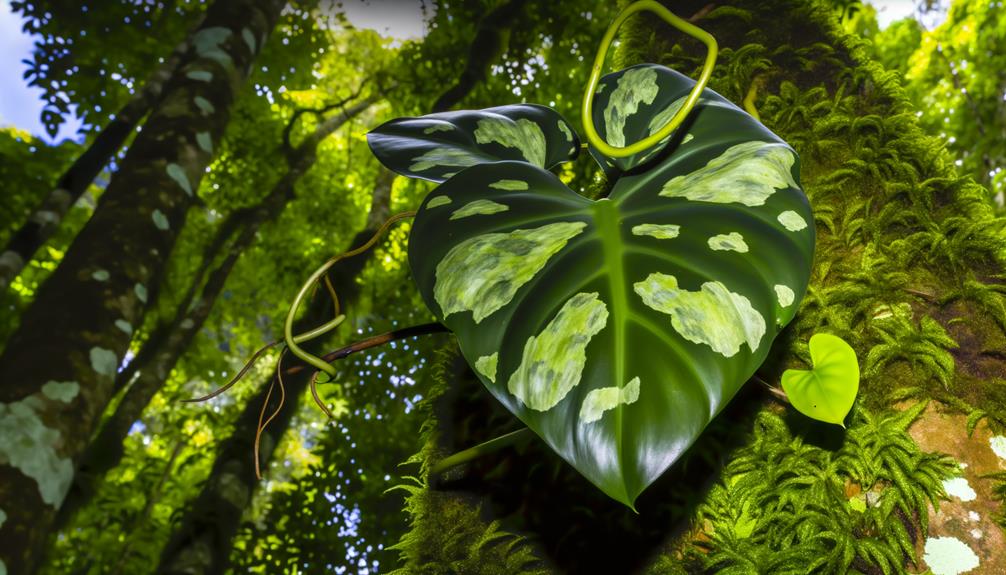
The Philodendron Brandtianum displays a vining growth habit, characterized by elongated stems that support heart-shaped leaves with striking silver markings, which thrive in a variety of light conditions. This plant's growth patterns can be examined through several key observations:
- Stem Elongation: The stems can extend significantly, reaching lengths up to several meters when provided with ideal support structures.
- Leaf Production: New leaves are continuously produced along the vine, ensuring a dense and lush appearance.
- Adventitious Roots: These roots emerge from nodes along the stem, aiding in nutrient uptake and anchoring the plant.
- Climbing Mechanism: Utilizing aerial roots and tendrils, the plant can ascend nearby supports, optimizing exposure to light.
This detailed understanding highlights the Philodendron Brandtianum's adaptive and robust growth strategy.
Climate Requirements
The Philodendron Brandtianum thrives in a specific climatic niche, characterized by an ideal temperature range between 65-80°F.
This species demonstrates a marked preference for high humidity levels, ideally between 60-80%, which supports its physiological and metabolic functions.
Understanding these climate requirements is essential for effectively cultivating and maintaining the health of this wild form.
Ideal Temperature Range
Peak growth for the wild form of the Philodendron Brandtianum is achieved within a temperature range of 65 to 80 degrees Fahrenheit, reflecting its native tropical habitat. This temperature range supports best physiological processes, such as photosynthesis and nutrient absorption.
Deviations outside this range can inhibit growth and stress the plant. To ensure ideal conditions, consider the following:
- Daytime Temperatures: Maintain between 70-75°F for enhanced metabolic activity.
- Nighttime Temperatures: Allow a slight drop to 65-70°F, simulating natural diurnal variations.
- Temperature Fluctuations: Avoid sudden changes exceeding 5-10°F to prevent thermal shock.
- Seasonal Adjustments: In cooler climates, use grow lights and heating mats to stabilize temperatures during winter months.
Understanding these parameters is essential for replicating the Philodendron Brandtianum's native environment.
Humidity Preferences
Optimal moisture levels for the wild form of the Philodendron Brandtianum are vital for maintaining its lush, vigorous growth and preventing physiological stress. This species thrives in environments with relative moisture levels ranging from 60% to 80%, mimicking its native tropical habitats.
Inadequate moisture can lead to desiccation of leaf margins, reduced photosynthetic efficiency, and increased susceptibility to pests such as spider mites. Conversely, excessive moisture may promote fungal infections and root rot. Hence, maintaining a balanced microclimate is essential.
For indoor cultivation, employing humidifiers or pebble trays, combined with regular misting, can effectively simulate optimal conditions. Additionally, monitoring ambient moisture with a hygrometer ensures precise control, fostering an environment conducive to the plant's health and aesthetic appeal.
Soil Preferences
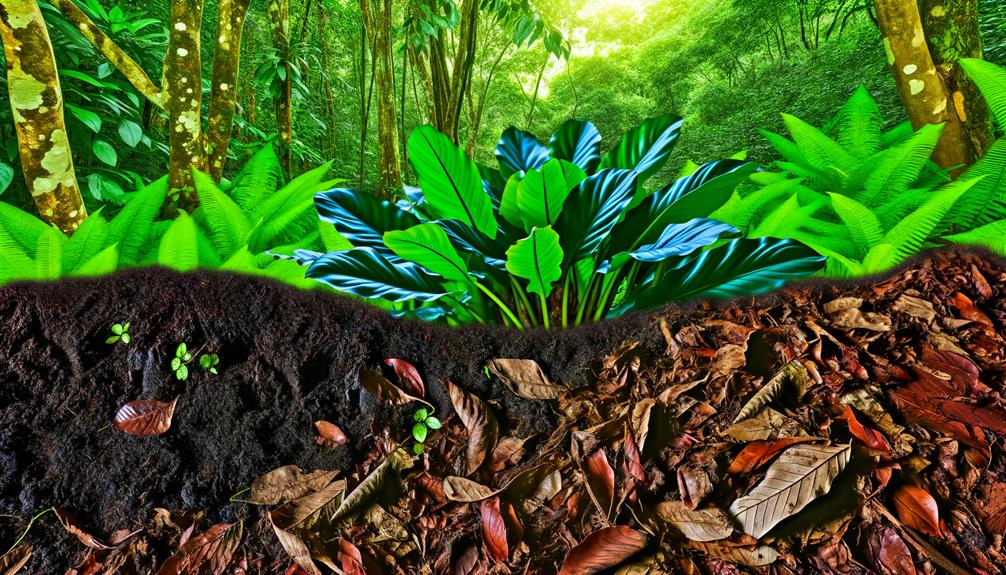
For best growth, Philodendron brandtianum requires a well-draining soil mix rich in organic matter and moderately acidic to neutral pH levels. The ideal soil composition enhances aeration and moisture retention, essential for the plant's root health and nutrient uptake.
A recommended soil mix can be achieved by combining:
- Peat Moss: Provides organic matter while maintaining moisture without waterlogging.
- Perlite: Enhances aeration and drainage, preventing soil compaction.
- Pine Bark: Adds structure and promotes water movement through the soil.
- Compost: Supplies essential nutrients and supports beneficial microbial activity.
These components synergistically create an environment that mimics the plant's natural habitat, ensuring robust growth and sustained well-being. Proper soil preparation is fundamental to cultivating a thriving Philodendron brandtianum.
Natural Adaptations
Philodendron brandtianum exhibits a range of natural adaptations, including epiphytic growth and efficient water storage mechanisms, which enable it to thrive in the fluctuating conditions of its native tropical habitat.
Its epiphytic nature allows it to anchor onto trees, accessing higher light levels while avoiding competition for soil nutrients. The development of specialized aerial roots facilitates moisture absorption directly from the air, a critical adaptation in environments with intermittent rainfall.
Additionally, its leaves possess hydrophobic properties that reduce water loss through transpiration. The plant's ability to store water in its tissues further contributes to its resilience during dry spells.
These adaptations collectively enhance the Philodendron brandtianum's survival and reproductive success in diverse and often challenging tropical ecosystems.
Wildlife Interactions

Beyond its remarkable natural adaptations, the wild Philodendron brandtianum engages in intricate interactions with the surrounding wildlife, forming symbiotic relationships that further enhance its ecological success.
These interactions can be categorized as follows:
- Pollination: Small insects such as beetles and flies are attracted to the plant's inflorescences, facilitating cross-pollination.
- Seed Dispersal: Birds and small mammals consume the plant's berries, aiding in the dispersion of seeds across various locations.
- Habitat Creation: The plant's extensive root system provides shelter and microhabitats for soil-dwelling organisms.
- Nutrient Cycling: Fallen leaves decompose, enriching the soil and benefiting surrounding flora and fauna.
These dynamic interactions underscore the plant's integral role within its ecosystem.
Conservation Status
The conservation status of the wild Philodendron brandtianum is currently of significant concern due to habitat loss, climate change, and illegal collection practices.
This species, native to the tropical rainforests of South America, particularly Brazil, is increasingly threatened by deforestation driven by agricultural expansion and urban development. Climate change further exacerbates these threats by altering precipitation patterns and increasing the frequency of extreme weather events, which disrupt its delicate rainforest ecosystem.
Additionally, the illegal collection of Philodendron brandtianum for the ornamental plant trade puts further pressure on wild populations. Conservation efforts must prioritize habitat preservation, enforce anti-poaching regulations, and promote sustainable cultivation practices to secure the survival of this ecologically significant species.
Conclusion
Philodendron brandtianum, thriving in the understory of South American rainforests, exhibits unique adaptive traits for survival. Its heart-shaped leaves, which can reach up to 30 cm in length, facilitate efficient photosynthesis in low-light conditions.
Remarkably, this species can grow up to 12 meters in length, climbing trees to access sunlight. The plant's interaction with native wildlife and its specific soil preferences highlight its ecological significance.
Current conservation efforts are essential to preserve its natural habitat and secure its survival.

